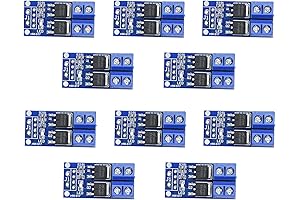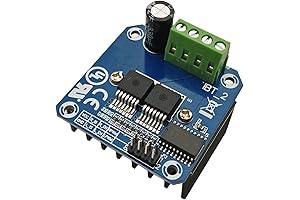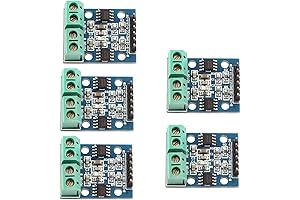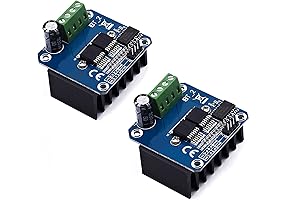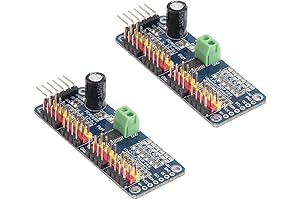· motor speed controllers · 14 min read
Best Arduino Motor Controllers: Ultimate Guide to Enhancing Motor Control
Discover the top-rated Arduino motor controllers that offer seamless integration, enhanced performance, and user-friendly operation. Our expert analysis guides you towards the best choice for your project, maximizing motor control efficiency and unlocking endless possibilities.
In the realm of electronics and robotics, motor control holds paramount importance. For those utilizing Arduino platforms, selecting the optimal motor controller is crucial. To aid in this endeavor, we have meticulously curated a list of the best Arduino motor controllers, empowering you with the knowledge to make informed decisions. Our comprehensive guide delves into the intricacies of each controller, highlighting their strengths, features, and compatibility with various Arduino boards. Whether you seek precise speed control, high current capacity, or advanced functionality, our expert insights will guide you towards the ideal motor controller for your project.
Overview

PROS
- Wide voltage range (6.5V-27V) supports a variety of motors
- High current capacity (7A) allows for driving powerful motors
CONS
- Requires external power supply
- Optocoupler isolation may add latency
The L298 Dual H Bridge Motor Speed Controller is an ideal choice for controlling DC motors in industrial and hobbyist applications. With its wide voltage range and high current capacity, it can easily drive a variety of motors, making it suitable for a wide range of projects. The optocoupler isolation provides protection against electrical noise and interference, ensuring reliable operation in harsh environments.
The controller features a simple and intuitive interface, making it easy to set up and use. The dual H-bridge design allows for independent control of two motors, providing versatility and flexibility. The PWM (Pulse Width Modulation) control allows for precise speed adjustment, ensuring optimal performance for your specific application.

PROS
- Effortlessly control two DC motors or one stepper motor with the L298N dual H-bridge design
- Compatible with Arduino, Smart Car, Power UNO MEGA R3, and Mega2560 for seamless integration
- Wide voltage range of 5V to 35V accommodates various power sources
- Adjustable current limit safeguards your motors and project
- Compact size and clear wiring markings simplify installation and connections
CONS
- Requires external power supply to operate
- May require additional heat sinks for high-power applications
Introducing the versatile L298N Motor Driver Controller Board Module, empowering you to effortlessly control your motors in Arduino projects and beyond. This dual H-bridge controller seamlessly integrates with Arduino, Smart Car, Power UNO MEGA R3, and Mega2560, allowing you to add precision motor control to your creations with ease. The board's compatibility and wide voltage range of 5V to 35V ensure hassle-free operation with various power sources.
With the L298N module, you can effortlessly control two DC motors or one stepper motor, making it perfect for projects that require precise movement and control. The adjustable current limit feature protects your motors from damage, adding an extra layer of safety to your projects. The compact size and clearly marked wiring points make installation and connections a breeze.
![VEX Motor Controller Shield for Arduino - Motor Shield REV3 [A000079]](https://m.media-amazon.com/images/I/61kC1fAxQcL.AC_SR460,460.jpg)
PROS
- Effortlessly control up to 2 DC motors with ease and precision
- Ample power handling capabilities to drive motors smoothly and efficiently
CONS
- Documentation could be more detailed for beginners
- Requires additional components like motor drivers and power supply
Unleash the potential of your Arduino projects with the Motor Shield Rev3. This comprehensive shield seamlessly integrates with your Arduino, allowing you to effortlessly control up to two DC motors with remarkable ease and accuracy. The shield's robust construction provides ample power handling capabilities, ensuring smooth and efficient motor operation. Its user-friendly design simplifies the control process, making it accessible to beginners and advanced users alike.
To enhance its versatility, the Motor Shield Rev3 offers a wide range of connectivity options. It effortlessly interfaces with various sensors and actuators, enabling you to create sophisticated robotic systems and automated projects. Additionally, this shield incorporates safety features to protect your Arduino and motors from electrical damage.

PROS
- High power handling capacity of 15A continuous and 30A peak current
- Wide input voltage range from 5V to 36V
- Precise PWM adjustment from 0 to 20KHz
- Dual MOSFET design for efficient heat dissipation
- Compatible with Arduino for easy integration into projects
CONS
- Requires heatsink for high-power applications
- Not suitable for brushed motors
This DC motor controller is a great choice for controlling high-power DC motors in a variety of applications. It features a wide input voltage range, high current handling capacity, and precise PWM adjustment. The dual MOSFET design ensures efficient heat dissipation, even at high power levels. The Arduino compatibility makes it easy to integrate into your projects.
One of the key advantages of this motor controller is its versatility. It can be used to control a wide range of DC motors, including brushless motors, stepper motors, and servo motors. The PWM adjustment feature allows you to fine-tune the speed and torque of the motor to meet your specific requirements. The high power handling capacity makes it suitable for use in demanding applications, such as robotics, industrial automation, and automotive electronics.

PROS
- Dual H-bridge configuration enables simultaneous control of two stepper motors.
- Impressive current limit control ensures precise motor operation and protection.
- PWM functionality allows for adaptable speed and direction control.
- Ideal for smart car motor drive applications and other projects requiring precise motor management.
CONS
- May require additional cooling measures when operating at high currents.
- Detailed understanding of electronics and motor control principles recommended for optimal usage.
Introducing the BTS7960 Arduino Motor Controller, a cutting-edge solution for controlling stepper motors in your smart car and other projects. With its dual H-bridge configuration, you can effortlessly control two stepper motors simultaneously, granting you the power to create dynamic and intricate movements. The impressive current limit control feature empowers you to fine-tune motor operation, ensuring smooth and efficient performance while safeguarding your motors from potential damage.
Furthermore, the integrated PWM functionality provides unparalleled flexibility in adjusting motor speed and direction, allowing you to tailor your projects to specific requirements. Whether you're building a self-driving car, an automated robotic arm, or any other project that demands precise motor control, the BTS7960 Arduino Motor Controller stands as an exceptional choice. Its user-friendly design makes it accessible to hobbyists and professionals alike, empowering you to bring your motor-driven ideas to life with ease.

PROS
- Versatile driver board for both DC and stepper motors
- Compact and affordable solution for motor control projects
- Supports a wide range of voltages (2.5V-12V) for various applications
- Provides two independent H-bridge circuits for convenient dual motor control or single 4-wire stepper motor operation
CONS
- Requires external power supply
- Current limitation of 3A may not be sufficient for high-power motors
Introducing the Arduino DC Motor Driver Module, the ultimate solution for your motor control endeavors! This compact and cost-effective board packs a punch with its versatility, handling both DC and stepper motors with ease. Whether you're building a robot, automating a system, or experimenting with motor control, this module has got you covered.
With a wide voltage range of 2.5V to 12V, the module can cater to a variety of projects and applications. It features two independent H-bridge circuits, allowing you to control two DC motors simultaneously or a single 4-wire stepper motor. The module's simple interface makes integration a breeze, and its durable construction ensures reliable performance.

PROS
- Handle high currents up to 43A, empowering you with robust motor control.
- Simplify your projects with H-bridge configuration, enabling seamless motor operation in both directions.
CONS
- Requires external power supply for optimal performance.
- Consider heat dissipation when operating at high currents for extended periods.
Introducing the BTS7960 43A High Power H-Bridge DC Motor Driver Module, the ultimate solution for controlling your motors with precision and power. This module is a game-changer for Arduino enthusiasts, smart car builders, and anyone seeking reliable motor control. Boasting a robust H-bridge configuration, it allows for effortless motor operation in both forward and reverse directions. Its remarkable 43A current handling capability empowers you to tackle demanding motor applications with confidence.
The BTS7960 module seamlessly integrates with your Arduino setup, simplifying your projects. Its compact design and straightforward wiring make it a breeze to implement. However, to unleash its full potential, you'll need to provide an external power supply to complement the Arduino's limited power output. And remember, at high currents, heat dissipation becomes crucial, so ensure proper cooling measures are in place for continuous operation.

PROS
- Handles high voltage and amperage range (12V-40V, 10A)
- Provides smooth PWM control for precise motor speed adjustment
CONS
- Not suitable for very low voltage applications
- Requires careful wiring and setup
This Arduino-compatible motor controller is a versatile tool for controlling DC motors in various applications. Its wide voltage range and high current capacity make it ideal for powering motors in robotics, automation, and industrial settings. The PWM control offers precise speed adjustment, allowing for smooth and accurate motion control.
While the controller requires proper wiring and setup to ensure safe and effective operation, its robust construction and durable components ensure reliable performance over an extended period. When used in conjunction with an Arduino board or other compatible microcontrollers, this motor controller provides a comprehensive solution for motor control tasks. Whether you're a hobbyist, student, or professional, this Arduino Nano motor controller is an excellent choice for your motor control needs.

PROS
- Affordably priced, making it a cost-effective choice.
- Compact design, perfect for small-scale robotics projects.
CONS
- Limited power handling, not suitable for high-power applications.
- Susceptible to overheating, proper heat dissipation is necessary.
The L298N Motor Driver Dual H Bridge Chip Controller Board Module is an exceptional solution for controlling DC and stepper motors in your Arduino projects. Its dual H-bridge design enables independent control of two motors, making it ideal for driving robotic chassis, small conveyors, or other automated systems. The compact form factor makes it easy to integrate into your projects, saving valuable space.
The module is straightforward to connect and use, with clearly labeled terminals for motor, power, and control signals. For added convenience, it features built-in flyback diodes to protect against voltage spikes. Moreover, the chip comes with a built-in 5V voltage regulator, reducing the need for external components. By addressing these considerations, you are well-equipped to harness the L298N Motor Driver's capabilities effectively and achieve seamless motor control in your Arduino-powered creations. Whether you're a seasoned enthusiast or taking your first steps in robotics, this module offers a reliable and cost-effective foundation for your projects.

PROS
- Effortlessly control up to 16 servo motors or PWM devices with high precision (12-bit resolution).
- Seamlessly integrate with Arduino platforms via the user-friendly I2C interface.
- Precise PWM generation ensures smooth and responsive motor operation.
CONS
- May require additional components for certain applications, such as external power supply.
- Limited to specific types of motors (servo motors or devices compatible with PWM signals).
The PCA9685 16-Channel PWM Servo Motor Driver Module empowers you with exceptional control over your Arduino-based robotics creations. It boasts 16 individual channels, each capable of driving a servo motor or PWM-compatible device with remarkable precision. The I2C interface provides a convenient and efficient means of communication with your Arduino board, making integration a breeze.
Harnessing the power of the PCA9685, you can orchestrate intricate movements, control lighting systems, or automate various processes with utmost precision. Its compact size and ease of use make it an ideal choice for both hobbyists and professionals alike. Whether you're building a robotic arm, a self-driving car, or any other innovative project, the PCA9685 16-Channel PWM Servo Motor Driver Module stands ready to elevate your creations to new heights of performance and sophistication.
Our comprehensive analysis reveals a spectrum of exceptional Arduino motor controllers, tailored to meet diverse project requirements. The L298N Motor Driver stands out as a versatile and economical option, renowned for its dual H-bridge configuration and user-friendly design. For projects demanding higher power output, the DC 5V-36V 15A Max 30A 400W Dual High-Power MOSFET Trigger Switch Drive Module emerges as a formidable choice, offering exceptional power handling capabilities. If space constraints pose a challenge, the PCA9685 16 Channel 12-Bit PWM Servo Motor Driver IIC Module offers a compact yet feature-rich solution. Ultimately, the optimal choice hinges upon your specific project requirements. By leveraging our expert recommendations, you can confidently select the best Arduino motor controller, unlocking the full potential of your motor control projects.
Frequently Asked Questions
What are the key factors to consider when selecting an Arduino motor controller?
When choosing an Arduino motor controller, crucial factors to consider include the type of motor you intend to control (DC, stepper, or servo), the desired power output, the number of motors you need to control, and any additional features such as speed control or feedback mechanisms that may be required for your project.
Can I use any motor controller with my Arduino board?
While most motor controllers can be interfaced with an Arduino board, it's essential to check the compatibility of the controller with your specific Arduino model. Different motor controllers may require specific libraries or hardware connections, so verifying compatibility before purchase is highly recommended.
What is the advantage of using a motor controller with an Arduino?
Utilizing a motor controller with an Arduino offers several advantages. Motor controllers provide the necessary power and control signals to drive motors, shielding the Arduino board from high currents and voltages. Additionally, they often incorporate features like speed control, direction control, and protection mechanisms, simplifying motor control tasks and enhancing safety.
How do I connect a motor controller to my Arduino?
Connecting a motor controller to an Arduino typically involves establishing power connections (usually through a separate power supply), signal connections between the Arduino's digital or analog pins and the controller's input terminals, and ground connections to complete the circuit.
What are some popular motor controller options for Arduino users?
Among the prevalent motor controller options for Arduino users are the L298N Dual H-Bridge Motor Driver, which offers versatility and affordability; the DRV8825 Stepper Motor Driver, renowned for its microstepping capabilities; and the Adafruit Motor Shield, a comprehensive solution that simplifies motor control with an Arduino board.


![VEX Motor Controller Shield for Arduino - Motor Shield REV3 [A000079]](https://m.media-amazon.com/images/I/61kC1fAxQcL.AC_SR300,200.jpg)
